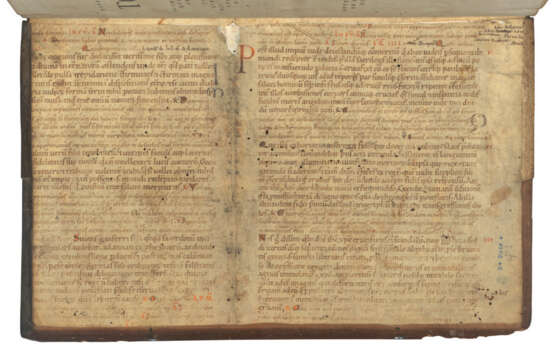ID 794547
Lot 2 | Anonymous German scriptorium
Estimate value
£ 4 000 – 6 000
Two partial bifolia from a noted Sacramentary on vellum, in Latin, surviving as pastedowns in HIERONYMUS, St (c.342-420). Omnium Operum, edited by Erasmus, vols. 1 and 2 bound in one volume. Basel: Johann Froben, 1516. Adams J-113 [southern Germany?, late 10th century]
Two very handsome and substantial early survivals from a Missal likely produced in a 10th-century German scriptorium, surviving in a contemporary Germanic binding of Froben's 1516 Omnium Operum of St Jerome, edited by Erasmus.
235 x 370mm (the bifolium). Two partial bifolia with consecutive text containing the feasts of St Othmar (16 November) and Cecilia (22 November), patron saint of music, surviving as pastedowns on upper and lower boards, 35 visible lines of text and St Gall neumes, with added notation continuing into the margins, the script a fine caroline minuscule in brown ink, enlarged initials touched in red, rubrics in red (left margin cropped, affecting text, some marginal browning and staining). Germanic half pigskin over wooden boards, remains of 2 fore-edge clasps, large rosette painted on fore-edges (somewhat scuffed and rubbed).
Provenance:
(1) The handsome letter-forms are very similar to the southern German hand of a broken-up Missal, the bulk of which is now in Berlin, Staatsbibliothek, Frag. 63, which was catalogued by Harmut Hoffmann as in a Regensburg hand of the last third of the 10th century (a leaf of which appeared at Christie’s, 13 December 2017, lot 2).
(2) The 16th-century binding is Germanic, and ink stamps on the title leaf reads: ‘Bibliothek des Franziskanerklosters Miltenberg’: the convent, founded in 1630, was dissolved in 1983.
Special notice
This lot is offered without reserve.
No VAT on hammer price or buyer's premium.
| Place of origin: | Western Europe, Germany, Europe |
|---|---|
| Auction house category: | Medieval & renaissance manuscripts |
| Place of origin: | Western Europe, Germany, Europe |
|---|---|
| Auction house category: | Medieval & renaissance manuscripts |
| Address of auction |
CHRISTIE'S 8 King Street, St. James's SW1Y 6QT London United Kingdom | |
|---|---|---|
| Preview |
| |
| Phone | +44 (0)20 7839 9060 | |
| Buyer Premium | see on Website | |
| Conditions of purchase | Conditions of purchase |





